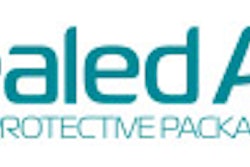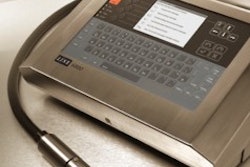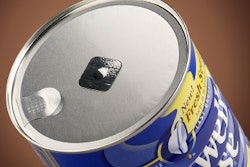
Sensotec has cut its packaging time and labor costs in half and reduced material costs by about $10ꯠ per year by eliminating a corrugated box-within-a-corrugated box packaging configuration to safeguard shipments of its sensitive sensors. It also eliminated the use of various dunnage materials.
Replacing those materials is Korrvu® retention packaging from Sealed Air’s Special Products Group (Danbury, CT). Korrvu includes a flat corrugated “retention frame.” A clear, elastomeric film is spot glued over a die-cut area on the frame. When the frame’s scored side flaps are folded upward, the resilient film loosens, forming a pocket into which a sensor is placed. The flaps are then folded back down to tighten the film and retain the sensor securely between the film and the corrugated frame. Those components are then inserted into a corrugated shipping case.
The Korrvu packaging represents a considerable packaging improvement, according to Carl Ballard, purchasing agent for Columbus, OH-based Sensotec. At its nearly 90ꯠ sq’ Columbus plant, the company designs and manufactures pressure transducers, load cells, and electronic sensor instruments used in industries as varied as automotive, medical, aviation, and welding. For packaging-related applications, Sensotec makes instruments used in drop testing and vibration analysis.
“We have around 80ꯠ products, in weights from ounces to hundreds of pounds,” Ballard estimates. “In the past, we typically wrapped a product in bubble material, applied masking tape, and put it in a corrugated box,” he adds. “Then we put that box into a larger corrugated box because we were concerned with the integrity of the package.” Packing station workers often added expanded polystyrene peanuts, foam dunnage, and paper within the outer case.
“We were successful in that we had very little product damage, but the problem was that one week a product might be packed one way, the next week another. We were challenged by the consistency and the professionalism of the package [interior] that went to the customer,” Ballard admits. The most pressing internal concern was the time (and labor) involved in packaging the instruments.
“If we were packing the same product day in and day out, it would be one thing,” he continues. “But we’re dealing with a multitude of product sizes and configurations. On top of that, our business continues to grow.”
Building consistency
Ballard explains that a few years ago Sensotec began a search for an alternative packaging process. It explored the idea of shrink-packaging systems, “but the investment in machines, determining how to cut board for all our products, how to shrink it properly, and the labor involved,” concerned the company. “And I’ve already got enough equipment in this building to maintain,” he adds. “We looked at air-filled packaging systems, and unique die-cuts,” he continues.
Ballard explains that during the search the company was mailed a promotional package that included a small bottle of Tabasco sauce protected within the Korrvu package. “I thought, ‘that’s pretty cool,’” he recalls. He adds that Sensotec has worked with Sealed Air for nearly 20 years. So the sensor maker decided to put Korrvu protective packaging to the test.
“We conducted independent testing of Korrvu packaging with Toledo Scale’s testing laboratory where they have their own UPS drop test. We packed our products in Korrvu and shipped them by truck and by air within the United States. We put packs in the trunks of our employees’ cars and they drove around town with them. We threw packs off our mezzanine and our dock,” he adds. The tests, he says, yielded “excellent results.”
What it is, how it works
Sealed Air ships Korrvu packaging to Sensotec in knocked-down, bundled quantities of 25 to 50. Ballard says operators use the material at three stations in the Columbus facility, for about 70% of the company’s products. The stainless-steel products packed in Korrvu usually weigh up to 8 lb, with a value ranging from $400 to $2ꯠ. Sensotec uses two box sizes, which Ballard says measure 6”x5”x5/8” and 7”x9”x3”.
The Korrvu retention pack includes a flat, die-cut corrugated board to which a clear, flexible film membrane is spot glued near the edges. An operator folds two side flaps upwards, which loosens the film to form what Sealed Air calls an “insertion pocket” into which the product is inserted. The side flaps are then folded back down, which tightens the film and holds the product securely in place between the film and the corrugated board. This component fits into an outer corrugated shipping case.
Sealed Air would not divulge specifications on the corrugated board or the film, which is custom-manufactured for the Sensotec application. It’s designed to provide resiliency, stretch and recovery characteristics, as well as good puncture-resistance, clarity, and frictional grab to hold the product in place.
Before top-and-bottom case taping to seal the shipper, an operator includes a paper calibration certificate on top of the Korrvu-packed sensor. “These packages were designed to size according to our calibration certificate envelopes,” Sensotec’s Ballard explains. “When the customer opens the box, the envelopes are folded so that they pretty much flap in your face.”
Happy customers
That was important, he says, “because with our previous packaging, we received numerous calls where customers couldn’t find this important calibration certificate,” Ballard recalls. “They were in the old package, but often they were underneath the bubble packaging or the peanuts, so people couldn’t find them because sometimes they were accidentally discarded.” That’s no longer a problem.
The sensors are shipped throughout the United States and exported in the Korrvu package. Ballard says these sensors need to be “recalibrated” on a regular basis. With the change in packaging, he says some customers are saving the packs and reusing them to ship instruments back to Sensotec for recalibration.
“Distributors and catalog houses that stock our sensors have been pleased with the [packaging] switch,” Ballard indicates, including companies in England and Germany. “Germany has very stringent guidelines when it comes to recycling, and the Korrvu packaging fits those criteria. Also, our English customer has expressed an interest in using retention packaging for its other products,” says Ballard.
Customers aren’t the only ones who appreciate the new pack. “Our employees like this package,” Ballard states, “and it takes about 50 percent less time to pack an item in this packaging, so we save a lot of time and labor costs.” And though he says, “we don’t ship an extremely high volume of boxes per day, we do save anywhere from 30 cents to one dollar per package just in materials. I would say we save in excess of $10ꯠ per year on material costs.
“We’ve been extremely pleased with the whole packaging system,” he says. “Since we started using Korrvu packaging, we haven’t had any complaints about missing parts or certificates. The package looks much more professional compared to the box-in-box configuration and the different dunnage materials. At this juncture I predict we will be expanding this packaging into different product applications in the future,” Ballard concludes.























